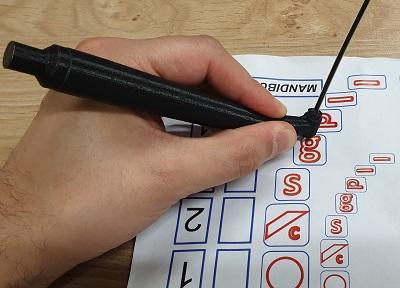
A University of Dundee lecturer has invented a new training device that enables dental students to develop their fine motor skills from home, allowing clinical techniques to be taught during pandemic restrictions at minimal cost.
Dr Clement Seeballuck, Clinical Lecturer in Paediatric Dentistry, came up with the idea for the Home Operational Practice Equipment (H.O.P.E.) more than a year ago but the work was expedited when face-to-face teaching was suspended in March.
H.O.P.E. has been specially crafted to simulate skills that your dentist might use for drilling and other procedures. The equipment includes a pen in the shape of a drill and enables students to develop indirect vision skills, becoming comfortable with the ergonomics of a dental handpiece as they manoeuvre the instrument as they would when working with a patient.
H.O.P.E. was developed using 3D printing equipment at the University and with the assistance of staff and students from the School of Dentistry, Duncan of Jordanstone College of Art & Design and the Library and Learning Centre. Dr Seeballuck and his colleagues developed a series of 3D-printed models that either simulate dental procedures or allow the users to engage in exercises that instil principles relevant to clinical practice.
This includes a base plate to replicate the angles and spaces between patients’ jaws that students learn to negotiate. Customised models of teeth can be fixed to the base plate, enabling students to complete various exercises related to their trade.
H.O.P.E. has been used in clinical skills classes taught by Dr Seeballuck and others, receiving positive staff and student feedback. One of the devices has also been used by a colleague recovering from long-term illness, to help strengthen their skills.
“Even before COVID-19 hit, there was a need for cost-effective practice devices,” said Dr Seeballuck. “Students want to practice skills at their own pace in a place they feel comfortable.
“The motor skills needed to precisely colour in shapes using the pen are similar to holding a drill. It makes sense to teach our students basic operational skills in a way that is safer for beginners, helping to build their confidence before handing them a drill.
“Richard Parsons, CIO Director of the LLC, saw the potential of the drill pens that I had been making by hand and dedicated time and resources to help move this into the digital realm using the 3D printer situated at the Library Create Space.
“I had also been working on different projects with Alasdair Napier, School support specialist at DJCAD, as well as two of our very enterprising dental students, Desmond Manangazira and Lau Tung Hin.
“The students had hidden 3D modelling talents, while Alasdair saw the merit of devices that could help solve the problems of safe interactive teaching in the era of social distancing. He dedicated his skills and the substantial printing resources of DJCAD to the project.
“This project would not have been realised in such a short time were it not for these collaborations and the commitment to learning and innovation at the University.”
Dr Seeballuck is currently investigating how to scale-up production and believes the drill pens could become widely used within the profession.
A standard training unit can cost thousands of pounds and need to be used in specially designed rooms. H.O.P.E costs a fraction of this, although it will not replace traditional clinical skills labs, it does enable practice outwith these settings. Dr Seeballuck believes the principles of skills practice will extend beyond dentistry and have applications in other courses too.
“Dentistry does not lend itself easily to remote learning, so the more ways we have of letting students learn outside the traditional settings the better,” he continued. “The main advantages over current devices is that the drill pens can be printed at a very low cost. H.O.P.E is also modular, making it easy to print new attachments to teach skills.
“Within the current COVID-19 era, the potential uses become more important. There is the possibility that students may have to isolate and having home equipment could be beneficial in a number of ways.
“In addition, the device could potentially be used to help reskill clinicians who have been away from the profession or lost confidence. They could also be used to safely give school students interested in dentistry a taste of the profession.”